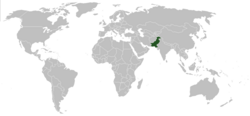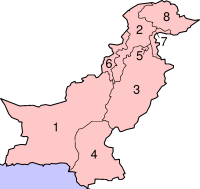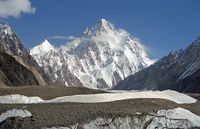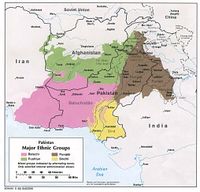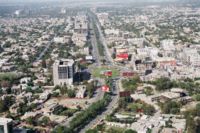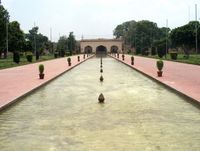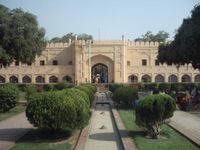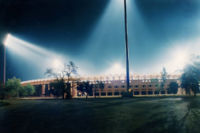Pakistan
2007 Schools Wikipedia Selection. Related subjects: Asian Countries; Countries
| اسلامی جمہوریۂ پاکستان Islami Jumhuriyah Pākistān Islamic Republic of Pakistan |
|||||
|
|||||
| Motto: Ittehad, Tanzim, Yaqeen-e-Muhkam ( Urdu) ("Unity, Discipline and Faith") |
|||||
| Anthem: Qaumi Tarana | |||||
| Capital | Islamabad |
||||
|---|---|---|---|---|---|
| Largest city | Karachi | ||||
| Official languages | Urdu, English | ||||
| Government | Semi-presidential system | ||||
| - President | Pervez Musharraf | ||||
| - Prime Minister | Shaukat Aziz | ||||
| Independence | from the United Kingdom | ||||
| - Abbasid Dynasty | 711-962 | ||||
| - Ghaznavid Empire | 962-1187 | ||||
| - Ghorid Kingdom | 1187-1206 | ||||
| - Delhi Sultanate | 1210-1526 | ||||
| - Mughal Empire | 1526-1707 | ||||
| - Declared | August 14, 1947 | ||||
| - Republic | March 23, 1956 | ||||
| Area | |||||
| - Total | 803,940 km² ( 36th) 310,403 sq mi |
||||
| - Water (%) | 3.1 | ||||
| Population | |||||
| - 2006 estimate | 165,803,560 ( 6th) | ||||
| - Density | 206/km² ( 53rd) 534/sq mi |
||||
| GDP ( PPP) | 2006 estimate | ||||
| - Total | $439.7 billion ( 26th) | ||||
| - Per capita | $2,829.5 ( 125th) | ||||
| HDI (2006) | 0.539 (medium) ( 134th) | ||||
| Currency | Rupee (Rs.) ( PKR) |
||||
| Time zone | PST ( UTC+5:00) | ||||
| - Summer ( DST) | not observed ( UTC+6:00) | ||||
| Internet TLD | .pk | ||||
| Calling code | +92 | ||||
Pakistan, officially the Islamic Republic of Pakistan ( Urdu: اسلامی جمہوریۂ پاکستان), is a country located in South Asia. It has a thousand-kilometre coastline along the Arabian Sea in the south and borders Afghanistan and Iran to the west, India to the east and the People's Republic of China in the far northeast.
Pakistan is the sixth most populous country in the world and is the second most populous Muslim country. It was established as a modern state in 1947, as one of the two parts of the partitioned British India, but the region has a long history of settlement and civilisation including the Indus Valley Civilisation. The region was invaded by Persians, Greeks, Arabs, Turks, Mongols, Afghans, and was incorporated into the British Raj in the nineteenth century. Since independence, Pakistan has experienced times of significant military and economic growth, and periods of instability, with the secession of East Pakistan (present-day Bangladesh). Pakistan is a declared nuclear weapons state.
Etymology
The name "Pakistan" ( IPA: [paːkɪst̪aːn]) means "Land of the Pure" in Urdu and Persian. It was coined in 1933 by Choudhary Rahmat Ali, who published it in the pamphlet Now or Never as an acronym of the names of the "Muslim homelands" of western India — P for Punjab, A for Afghania (the Afghan (Pashtun) areas in the Northwest Frontier Province), K for Kashmir, S for Sindh and tan for Balochistan. The i was later added to the name since in Urdu, the national language of Pakistan, "istan" refers to "land of" while "pak" means pure. Officially, the nation was founded as the Dominion of Pakistan in 1947, and was renamed as the Islamic Republic of Pakistan in 1957.
History
The modern day Pakistan consists of four major parts called provinces Punjab, Sind, Balochistan and NWFP.Modern Pakistan is a country that has , Harappan, Aryan, Persian, Greek, Saka, Parthian, Kushan, White Hun, Afghan, Arab, Turkic, and Mughal heritage. Waves of invaders and migrants settled down in Pakistan through out the centuries, influencing the locals and being absorbed among them. Pakistan is home to the oldest Asian civilisation (and one of the oldest in the world after Mesopotamia and Egypt), Indus Valley Civilization (2500 BC - 1500 BC). The modern state of Pakistan was established on 14 August 1947, but the region it encompasses has an extensive history that overlaps with the histories of Ancient India, Iran and Afghanistan. The region is a crossroad of historic trade routes, including the Silk Road, and was settled over thousands of years by many groups, including Dravidians, Indo-Aryans, Persians, Macedonians, Greeks, Scythians, Parthians Kushans, White Huns, Afghans, Arabs, Turks, and Mongols. The earliest evidence of humans in the region are pebble tools from the Soan Culture in the province of Punjab, dated from 100,000 to 500,000 years ago. The Indus region was the site of several ancient cultures including Mehrgarh, one of the world's earliest known towns, and the Indus Valley Civilisation at Harrappa and Mohenjo-Daro.
.
The Indus Valley civilisation collapsed in the middle of the second millennium BCE and was followed by the Vedic Civilisation, which extended over much of northern India and Pakistan. Successive empires and kingdoms ruled the region from the Achaemenid Persian empire around 543 BCE, to Alexander the Great in 326 BCE and the Mauryan empire. The Indo-Greek Kingdom founded by Demetrius of Bactria included Gandhara and Punjab from 184 BCE, and reached its greatest extent under Menander, establishing the Greco-Buddhist period with advances in trade and culture. The city of Taxila (Takshashila) became a major centre of learning in ancient times - the remains of the city, located to the west of Islamabad, are one of the country's major archaeological sites.
In 712 CE, the Arab general Muhammad bin Qasim conquered Sindh and Multan in southern Punjab, setting the stage for several successive Muslim empires including the Ghaznavid Empire, the Ghorid Kingdom, the Delhi Sultanate and the Mughal Empire. During this period Sufi missionaries played a pivotal role in converting a majority of the regional Hindu population to Islam. The gradual decline of the Mughal Empire in the early eighteenth century provided opportunities for the Afghans, Balochis and Sikhs to exercise control over large areas until the British East India Company gained ascendancy over South Asia.
The War of Independence in 1857 was the region's last major armed struggle against the British Raj, and it laid the foundations for the generally unarmed freedom struggle led by the Congress. However, the Muslim League rose to popularity in the late 1930's amid fears of under-representation and neglect of Muslims in politics. On 29 December 1930, Allama Iqbal's presidential address called for a separate Muslim state in northwest and eastern South Asia. Muhammad Ali Jinnah espoused the Two Nation Theory and led the Muslim League to adopt the Lahore Resolution of 1940, which ultimately led to the creation of Pakistan.
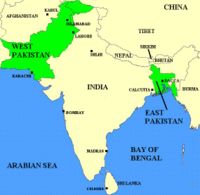
Pakistan was formed on 14 August 1947 with two Muslim-majority wings in the eastern and northwestern regions of South Asia, separated by Hindu-majority India, and comprising the provinces of Balochistan, East Bengal, the North-West Frontier Province, West Punjab and Sindh. The partition of British India resulted in communal riots across India and Pakistan—millions of Muslims moved to Pakistan and millions of Hindus and Sikhs moved to India. Disputes arose over several princely states including Jammu and Kashmir whose ruler had acceded to India and finally led to the First Kashmir War (1948) ending with Pakistan and India each occupying large parts of the state. From 1947 to 1956, Pakistan was a Dominion in the Commonwealth of Nations. The republic declared in 1958 was stalled by a coup d'etat by Ayub Khan (1958–69), who was president during a period of internal instability and a second war with India in 1965. His successor, Yahya Khan (1969–71) had to deal with the cyclone which caused 500,000 deaths in East Pakistan.
Economic and political dissent in East Pakistan led to violent political repression and tensions escalating into civil war ( Bangladesh Liberation War) and the Indo-Pakistani War of 1971 and ultimately the secession of East Pakistan as the independent state of Bangladesh.
Civilian rule resumed from 1972 to 1977 under Zulfikar Ali Bhutto, until he was deposed and later sentenced to death in what accounts to a judicial murder in 1979 by General Zia-ul-Haq, who became the third military president. Pakistan's secular policies were replaced by Zia's introduction of the Islamic Shariah legal code, which increased religious influences on the civil service and the military. With the death of General Zia in a plane crash in 1988, Benazir Bhutto, daughter of Zulfikar Ali Bhutto, was elected as the first female Prime Minister of Pakistan. Over the next decade, she alternated power with Nawaz Sharif, as the country's political and economic situation worsened. Pakistan sent 5,000 troops to the 1991 Gulf War as part of a US led coalition and specifically for the defence of Saudi Arabia. Military tensions in the Kargil conflict with India in 1999 was followed by a military coup in which General Pervez Musharraf assumed executive powers. In 2001, Musharraf became President after the resignation of Rafiq Tarar. After the 2002 parliamentary elections, Musharraf transferred executive powers to newly elected Prime Minister Zafarullah Khan Jamali, who was succeeded in the 2004 Prime-Ministerial election by Shaukat Aziz.
Government and politics
The Muslim League formed Pakistan's first government under the leadership of Muhammad Ali Jinnah and Liaquat Ali Khan. The Muslim League's leadership of Pakistani politics decreased significantly with the rise of other political parties, with the Pakistan People's Party in West Pakistan, and the Awami League in East Pakistan, which would ultimately lead to the creation of Bangladesh. The first Constitution of Pakistan was adopted in 1956, but was suspended in 1958 by Ayub Khan. The Constitution of 1973, suspended in 1977 by Zia-ul-Haq, was re-instated in 1991 and is the country's most important document, laying the foundations of government. Pakistan is a federal democratic republic with Islam as the state religion. The semi-presidential system includes a bicameral legislature consisting of a 100-member Senate and a 342-member National Assembly. The President is the Head of State and the Commander in Chief of the Armed Forces and is elected by an electoral college. The prime minister is usually the leader of the largest party in the National Assembly. Each province has a similar system of government with a directly elected Provincial Assembly in which the leader of the largest party or alliance becomes Chief Minister. Provincial Governors are selected by the Provincial Assemblies on the advice of the Chief Minister.
The Pakistani military has played an influential role in mainstream politics throughout Pakistan's history, with military presidents ruling from 1958–71, 1977–88 and from 1999 onwards. The leftist Pakistan People's Party (PPP), led by Zulfikar Ali Bhutto, emerged as a major political player during the 1970s. Under the military rule of Muhammad Zia-ul-Haq, Pakistan began a marked shift from the British-era secular politics and policies, to the adoption of Shariat and other laws based on Islam. During the 1980s, the anti- feudal, pro- Muhajir Muttahida Qaumi Movement (MQM) was started by unorthodox and educated urban dwellers of Sindh and particularly Karachi. The 1990s were characterized by coalition politics dominated by the PPP and a rejuvenated Muslim League.
In the October 2002 general elections, the Pakistan Muslim League (Q) (PML-Q) won a plurality of National Assembly seats with the second-largest group being the Pakistan People's Party Parliamentarians (PPPP), a sub-party of the PPP. Zafarullah Khan Jamali of PML-Q emerged as Prime Minister but resigned on 26 June 2004 and was replaced by PML-Q leader Chaudhry Shujaat Hussain as interim Prime Minister. On 28 August 2004 the National Assembly voted 191 to 151 to elect the Finance Minister and former Citibank Vice President Shaukat Aziz as Prime Minister. Muttahida Majlis-e-Amal, a coalition of Islamic religious parties, won elections in North-West Frontier Province, and increased their representation in the National Assembly.
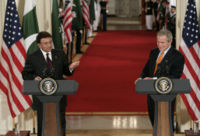
Pakistan is an active member of the United Nations (UN) and the Organisation of the Islamic Conference (OIC), the latter of which Pakistan has used as a forum for Enlightened Moderation, a plan to promote a renaissance and enlightenment in the Muslim world. Pakistan is also a member of the major regional organisations of the South Asian Association for Regional Cooperation (SAARC) and the Economic Cooperation Organisation (ECO). In the past, Pakistan has had mixed relations with the United States especially in the early 1950s when Pakistan was the United States' "most allied ally in Asia" and a member of both the Central Treaty Organisation (CENTO) and the Southeast Asia Treaty Organisation (SEATO). During the Soviet-Afghan War in the 1980s Pakistan was a crucial US ally, but relations soured in the 1990s, when sanctions were applied by the US over suspicions of Pakistan's nuclear activities. The September 11 attacks and the subsequent War on Terrorism have seen an improvement in US–Pakistan ties, especially after Pakistan ended its support of the Taliban regime in Kabul. In January 2004, founder of Pakistani nuclear program A. Q. Khan confessed of nuclear proliferation to Libya, Iran and North Korea. On 5 February 2004, the president Pervez Musharraf, announced that he had pardoned A. Q. Khan.
Pakistan has long had troubled relations with neighbouring India. The long-running dispute over Kashmir resulted in full fledged wars in 1947 and 1965. Civil war in 1971 flared into the simultaneous Bangladeshi Liberation War and the Indo-Pakistani War of 1971. Pakistan conducted nuclear weapon tests in 1998 to counterbalance India's nuclear tests and became the only Muslim nuclear weapons state. The relations with India are steadily improving following peace initiatives in 2002. Pakistan maintains close economic, military and political relationships with the People's Republic of China.
Pakistan also faces instability in the Federally Administered Tribal Areas, where some tribal leaders support the Taliban. Pakistan has had to deploy the army in these regions to suppress the local unrest, in Waziristan. The Waziristan conflict ended with a recently declared peace agreement between the tribal leaders and the Pakistani government, that is expected to bring back stability to the region. Additionally, the country has long faced instability in its largest province, Balochistan. The army was deployed to fight a serious insurgency within the province from 1973–76. Social stability resumed after Rahimuddin Khan was appointed martial law administrator beginning in 1977. After relative peace throughout the 1980s and 1990s, some influential Baloch tribal leaders restarted a separatist movement after Pervez Musharraf took over in 1999. In a recent incident Nawab Akbar Bugti, the leader of Balochistan, was killed in August 2006 by Pakistani military forces.
Administrative divisions
Pakistan is a federation of four provinces, a capital territory and federally administered tribal areas. Pakistan exercises de facto jurisdiction over the western parts of the Kashmir region, organised as two separate political entities ( Azad Kashmir and Northern Areas), which are also claimed by India. In 2001 the federal government abolished the third tier of government ( administrative divisions) in favour of the former fourth tier districts. The provinces and the capital territory are subdivided into a total of 107 districts which contain numerous tehsils and local governments. The tribal areas comprise seven tribal agencies and six small frontier regions detached from neighbouring districts whilst Azad Kashmir comprises seven districts and Northern Areas comprises six districts.
Provinces:
- Balochistan
- North-West Frontier Province (NWFP)
- Punjab
- Sindh
-
- Balochistan and NWFP also have Provincially Administered Tribal Areas (FATA) which are being developed into regular districts.
Territories:
- Islamabad Capital Territory
- Federally Administered Tribal Areas
Pakistani-administered portions of the Kashmir:
- Azad Kashmir
- Northern Areas
Geography and climate
Pakistan covers 803,940 square kilometres (310,403 square miles), approximately the combined land areas of France and the United Kingdom, with its eastern regions located on the Indian tectonic plate and the western and northern regions on the Iranian plateau and Eurasian landplate. Apart from the 1,046 kilometre (650 mi) Arabian Sea coastline, Pakistan's land borders total 6,774 kilometres—2,430 kilometres (1,509 mi) with Afghanistan to the northwest, 523 kilometres (325 mi) with China to the northeast, 2,912 kilometres (1,809 mi) with India to the east and 909 kilometres (565 mi) with Iran to the southwest.
The different types of natural features range from the sandy beaches, lagoons, and mangrove swamps of the southern coast to preserved beautiful moist temperate forests and the icy peaks of the Himalaya, Karakoram and Hindu Kush mountains in the north. There are an estimated 108 peaks above 7,000 metres (23,000 ft) high that are covered in snow and glaciers. Five of the mountains in Pakistan (including K2 and Nanga Parbat) are over 8,000 metres (26,000 ft). Indian-controlled Kashmir to the Northern Areas of Pakistan and running the length of the country is the Indus River with its many tributaries. The northern parts of Pakistan attract a large number of foreign tourists. To the west of the Indus are the dry, hilly deserts of Balochistan; to the east are the rolling sand dunes of the Thar Desert. The Tharparkar desert in the southern province of Sindh, is the only fertile desert in the world. Most areas of Punjab and parts of Sindh are fertile plains where agriculture is of great importance.
The climate varies as much as the scenery, with cold winters and hot summers in the north and a mild climate in the south, moderated by the influence of the ocean. The central parts have extremely hot summers with temperatures rising to 45 °C (113 °F), followed by very cold winters, often falling below freezing. There is very little rainfall ranging from less than 250 millimetres to more than 1,250 millimetres (9.8–49.2 in), mostly brought by the unreliable south-westerly monsoon winds during the late summer. The construction of dams on the rivers and the drilling of water wells in many drier areas have eased water shortages.
Flora and fauna
The wide variety of landscapes and climates in Pakistan allows for a wide variety of wild animals and birds. The forests range from coniferous alpine and subalpine trees such as spruce, pine, and deodar cedar in the northern mountains to deciduous trees such as the mulberry-type Shisham in the Sulaiman range in the south. The western hills have juniper and tamarisk as well as coarse grasses and scrub plants. Along the coast are mangrove forests which form much of the coastal wetlands.
In the south, there are crocodiles in the murky waters at the mouth of the Indus River whilst on the banks of the river, there are boars, deer, porcupines, and small rodents. In the sandy scrublands of central Pakistan are found jackals, hyenas, wild cats, panthers, and leopards while the clear blue skies abound with hawks, falcons, and eagles. In the southwestern deserts are rare Asiatic cheetahs. In the northern mountains are a variety of endangered animals including Marco Polo sheep, Urial sheep, Markhor and Ibex goats, black and brown Himalayan bears, and the rare Snow Leopard. During August 2006, Pakistan donated an orphaned snow leopard cub called Leo to USA. Another rare species is the blind Indus River Dolphin of which there are believed to be about 1,000 remaining, protected in two major sanctuaries. In recent years the number of wild animals being killed for fur and leather trading led to a new law banning the hunting of wild animals and birds and the establishment of several wildlife sanctuaries and game reserves.
Economy
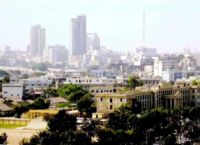
Pakistan is an rapidly developing country which has faced a number of challenges on both political and economic fronts. Despite being a very poor country in 1947, Pakistan's economic growth rate was better than the global average during the subsequent four decades, but imprudent policies led to a slowdown in the late 1990's. Recently, wide-ranging economic reforms have resulted in a stronger economic outlook and accelerated growth especially in the manufacturing and financial services sectors. There has been great improvement in the foreign exchange position and rapid growth in hard currency reserves in recent years. The 2005 estimate of foreign debt was close to US$40 billion. However, this has decreased in recent years with assistance from the International Monetary Fund (IMF) and significant debt-relief from the United States. Pakistan's gross domestic product, as measured by purchasing power parity (PPP), is estimated to be US$439.7 billion while its per capita income (PCI) stands at $2,803. Despite clear progress, reports by the Asian Development Bank, the World Bank and the UN Development Program place the poverty rate in Pakistan between 23-28 percent. Pakistan's GDP growth rates have seen a steady increase over the last 5 years. However, inflationary pressures and a below par savings rate, among other economic factors, could make it difficult to sustain a high growth rate according to some analysts.
The growth of non-agricultural sectors has changed the structure of the economy, and agriculture now only accounts for roughly 20% of the GDP. The service sector accounts for 53% of the country's GDP with wholesale and retail trade forming 30% of this sector. In recent times, the Karachi Stock Exchange has soared, along with most of the world's emerging markets. Large amounts of foreign investments have been made into several industries. The top industries in Pakistan are telecom, software, automotives, textiles, cement, fertilizer, steel, ship building, and more recently, aerospace.
Pakistan has accomplished many engineering feats such as construction of the world’s largest earth filled dam Tarbela, the world's twelfth largest dam Mangla, as well as the world’s highest international road: the Karakoram Highway. There are also half a dozen additional dams planned such as Kalabagh Dam, Diamer-Bhasha Dam, Munda, Akhori and Skardu Katzara.
In november 2006 China and Pakistan signed a Free Trade Agreement hoping to triple bilateral trade from $4.2 billion ( USD) to $15 billion ( USD) within the next five years. Pakistan's annual exports in 2005 ammounted to $15 billion ( USD), and is poised to cross $18 billion ( USD) in 2006 and $20 billion ( USD) in 2007.. Pakistan is also home to a thriving arms industry which exports $200 million ( USD) annually, mostly defence equipment and arms to countries in the Middle East and South Asia, and its defence officials are hopeful that these exports will surpass $500 million ( USD) a year within the next five years.
Demographics
Pakistan has an estimated population of 165,803,560, as of April 2006. Pakistan has the world's sixth largest population, placing it higher than Russia, and lower than Brazil. Because of Pakistan's high growth rate, it is expected to surpass Brazil in population in the year 2020. Population projections for Pakistan are relatively difficult because of the apparent differences in the accuracy of each census and the inconsistencies between various surveys related to fertility rate, but it is likely that the rate of growth peaked in 1980s. The population was estimated at 162,400,000 on July 1, 2005, with a fertility rate of 34 per thousand, a death rate of 10 per thousand, and the rate of natural increase at 2.4%. Pakistan also has a high infant mortality rate of 70 per thousand births.
Urdu is the national language and lingua franca of Pakistan, and English is the official language used in the Constitution and widely used by corporate businesses, the educated urban elite, and most universities. Punjabi is spoken by over 60 million people, but has no official recognition in the country. These major ethnic groups are further broken down into several smaller ethnic groups - Punjabis (44.68)% of the population, Pashtuns (15.42%), Sindhis (14.1%), Seraikis (10.53%), Muhajirs (7.57%), Balochis (3.57%) and others (4.66%) such as Tajiks, Bengalis and many others.
The demographics of religion in Pakistan were significantly influenced in 1947 by the movement of Muslims to Pakistan, and Hindus and Sikhs to India. Census data indicates that 96% of the population are Muslims, of whom nearly 80% are Sunni Muslims and 19% are Shi'a Muslims. The remainder comprises of Christians, Hindus, Jews, Sikhs, Parsis, Ahmadis, and Animists (mainly the Kalasha of Chitral). A few Buddhists are included in Pakistani statistics; however, these live in Indian administered Ladakh which Pakistan claims along with the rest of Kashmir. As of 2005, over three million refugees (approximately 81.5% being ethnic Pashtuns) remain in Pakistan as a result of the wars in Afghanistan, with 83% of these refugees reporting their intent to permanently settle in Pakistan.
Society and culture
Pakistan has a rich and unique culture that has preserved established traditions throughout history. Many cultural practices, foods, monuments, and shrines were inherited from the rule of Muslim Mughal and Afghan emperors including the national dress of Shalwar Qameez. Women wear brightly coloured shalwar qameez, while men often wear solid-coloured ones, usually with a sherwani or achkan (long coat) that is worn over the garment.
The variety of Pakistani music ranges from diverse provincial folk music and traditional styles such as Qawwali and Ghazal Gayaki to modern forms fusing traditional and western music, such as the synchronisation of Qawwali and western music by the renowned Nusrat Fateh Ali Khan. Other major Ghazal singers include Mehdi Hassan, Ghulam Ali, Farida Khanum, Tahira Syed, Abida Parveen and Iqbal Bano. The arrival of Afghan refugees in the western provinces has rekindled Pashto and Persian music and established Peshawar as a hub for Afghan musicians and a distribution centre for Afghan music abroad. Until the 1990s, the state-owned Pakistan Television Corporation (PTV) and Pakistan Broadcasting Corporation were the dominant media outlets, but there are now numerous private television channels such as Geo TV, Indus TV, Hum, ARY, KTN and others. Various American, European, and Asian television channels and movies are available to the majority of the Pakistani population via cable and satellite television. There are also small indigenous movie industries based in Lahore and Peshawar (often referred to as Lollywood and Pollywood). Although Bollywood movies are banned since 1965, Indian film stars are generally popular in Pakistan.
Pakistani society is largely multilingual and predominantly Muslim, with high regard for traditional family values, although urban families have grown into a nuclear family system due to the socio-economic constraints imposed by the traditional joint family system. Recent decades have seen the emergence of a middle class in cities like Karachi, Lahore, Rawalpindi, Hyderabad, Faisalabad, Sukkur and Peshawar that wish to move in a more liberal direction, as opposed to the northwestern regions bordering Afghanistan that remain highly conservative and dominated by centuries-old regional tribal customs. Increasing globalization has increased the influence of "Western culture" with Pakistan ranking 46th on the Kearney/FP Globalization Index. There are an approximated four million Pakistanis living abroad, with close to a half-million expatriates living in the United States and around a million living in Saudi Arabia.As well as nearly one million people of Pakistani descent in the United Kingdom, there are burgeoning cultural connections.
Tourism is a growing industry in Pakistan, based on its diverse cultures, peoples and landscapes. The variety of attractions range from the ruins of ancient civilizations such as Mohenjo-daro, Harappa and Taxila, to the Himalayan hill stations, which attract those interested in field and winter sports. Pakistan is home to several mountain peaks over 7000m, which attracts adventurers and mountaineers from around the world, especially K2. The northern parts of Pakistan have many old fortresses, towers and other architecture as well as the Hunza and Chitral valleys, the latter being home to the small pre-Islamic Animist Kalasha community who claim descent from the army of Alexander the Great. In the Punjab is the site of Alexander's battle on the Jhelum River and the historic city Lahore, Pakistan's cultural capital with many examples of Mughal architecture such as the Badshahi Masjid, Shalimar Gardens, Tomb of Jahangir and the Lahore Fort. To promote Pakistan's unique and various cultural heritage, the prime minister launched "Visit Pakistan 2007".
Holidays
There are many holidays and festivals celebrated annually in Pakistan. While Pakistan is an Islamic nation, there are also several secular holidays including Pakistan Day ( 23 March), Independence Day ( 14 August), Defence of Pakistan Day ( 6 September), Pakistan Air Force Day ( 7 September), the anniversaries of the birth ( 25 December) and death ( 11 September) of Quaid-e-Azam, Allama Iqbal ( 9 November) and the birth ( 30 July) and death ( 8 July) of Madar-e-Millat. Labour Day (also known as May Day) is also observed in Pakistan on 1 May.
Several important festivals are celebrated by Pakistani Muslims during the year, dependent on the Islamic calendar. Ramadan, the ninth month of the calendar, is characterised by daytime fasting for 29 or 30 days and is followed by the festival of Eid ul-Fitr. In a second festival, Eid ul-Adha, an animal is sacrificed in remembrance of the actions of Abraham and the meat is shared with friends, family, and the less fortunate. Both Eid festivals are public holidays, serving as opportunities for people to visit family and friends, and for children to receive new clothes, presents, and sweets. Some Muslims celebrate Eid-e-Milad-un-Nabi, the birthday of the prophet Muhammad, in the third month of the calendar ( Rabi' al-Awwal). Shia Muslims mark the Day of Ashurah on the 9th and 10th days of the first month ( Muharram) to commemorate the martyrdom of Husayn bin Ali, (the grandson of the Prophet Muhammad).
Hindus, Buddhists, Sikhs, and Christians in Pakistan also celebrate their own festivals and holidays. Sikhs come from across the world to visit several holy sites in Punjab, including the shrine of Guru Nanak, the founder of Sikhism, at Hassan Abdal in the Attock District, and his birthplace, at Nankana Sahib. There are also several regional and local festivals, such as the Punjabi festival of Basant, which marks the start of spring and is celebrated by kite flying.
Sports
The official and national sport of Pakistan is field hockey, although squash and cricket are also very popular. The national cricket team has won the Cricket World Cup once (in 1992), were runners-up once (in 1999) and co-hosted the games twice (in 1987 and 1996). The team has also won the Australasia Cup thrice (1986, 1990, 1994). Pakistan has also produced a number of successful world-class squash players such as Jahangir Khan and Jansher Khan. Muhammad Yousuf was remained world champion in game of snooker in 1990's. At an international level, Pakistan has competed many times at the Summer Olympics in field hockey, boxing, athletics, swimming, and shooting. Pakistan's medal tally remains at 10 medals (3 gold, 3 silver and 4 bronze) while at the Commonwealth games and Asian Games it stands at 61 medals and 182 medals respectively. Hockey is the sport that Pakistan has been most successful at the Olympics, with three gold medals ( 1960, 1968, 1984). Pakistan has also won the Hockey World Cup a record four times (1971, 1978, 1982, 1994). Pakistan has hosted several international competitions, including the SAF Games in 1989 and 2004.
A1 Grand Prix racing is also becoming popular with the entry of a Pakistani team in the 2005 season. The Tour de Pakistan, modelled on the Tour de France, is an annual cycling competition that covers the length and breadth of Pakistan. Recently, football has grown in popularity across the country, where traditionally it had been played almost exclusively in the western province of Balochistan.


